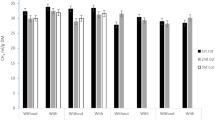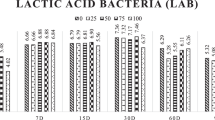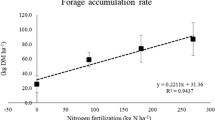Abstract
SILAGE of good quality has a pH of 4.2 or less, with the possible exception of silage made from wilted materials. If grass with a high protein content is ensiled, acids or carbohydrates may have to be added to obtain such a low pH. It seems, however, that merely crushing the grass also has the effect of lowering the pH. Gneist1 probably was the first who noticed that crushing resulted in lower losses of nitrogen-free extractives and digestible protein. He ascribed this effect to the inactivation of enzymes. Crasemann and Heinzl2 found that the formation of lactic acid was speeded up by crushing. Watson3 is of the same opinion, and thinks that it might be possible to make good silage merely by crushing.
This is a preview of subscription content, access via your institution
Access options
Subscribe to this journal
Receive 51 print issues and online access
$199.00 per year
only $3.90 per issue
Buy this article
- Purchase on Springer Link
- Instant access to full article PDF
Prices may be subject to local taxes which are calculated during checkout
Similar content being viewed by others
References
Gneist, K., Forschungsdienst, 17, 416 (1944).
Crasemann, E., and Heinzl, O., J. Brit. Grassl. Soc., 4, 263 (1949).
Watson, S. J., “Grassland and Grassland Products” (London, 1951).
Brouwer, E., Versl. Land. Onderz., 43, 55 (1937).
Author information
Authors and Affiliations
Rights and permissions
About this article
Cite this article
DE MAN, J. Influence of Crushing on the pH of Grass Silage. Nature 169, 246–247 (1952). https://doi.org/10.1038/169246b0
Issue Date:
DOI: https://doi.org/10.1038/169246b0
This article is cited by
-
Influence of Crushing on the pH of Grass Silage
Nature (1952)
Comments
By submitting a comment you agree to abide by our Terms and Community Guidelines. If you find something abusive or that does not comply with our terms or guidelines please flag it as inappropriate.



